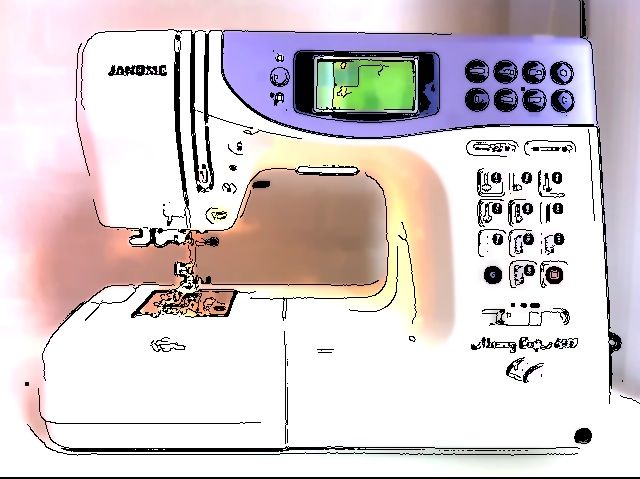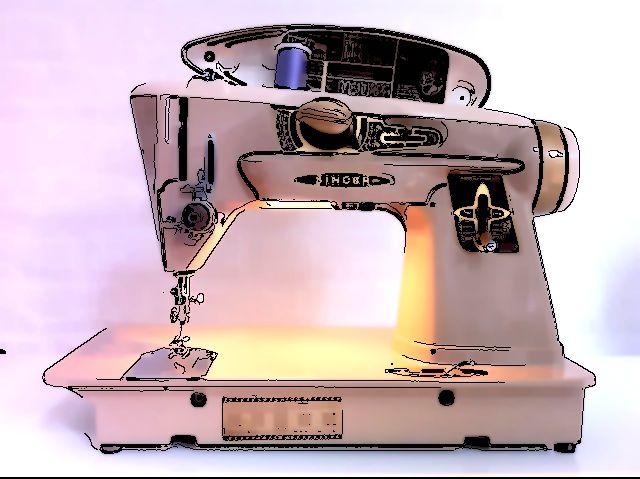 |
| Janome MemoryCraft 4900QC |
My modern machine is a Janome MemoryCraft 4900QC, and is about 2 years old. This model isn't made anymore, but the 5400 is very similar. I think of it as the Toyota Camry of sewing machines, somewhere between the economy models and the luxury mega-stitchers. It was like $700, I think, and it has served me well so far.
 |
| Singer 500A |
By contrast, the Singer 500A was the top-of-the line machine of its era. Mine was made in 1962, and would have cost a couple hundred dollars new, a huge sum in the economy of the day. It has a slanted shank, and a number of built-in decorative stitches. Plus it looks cool -- way cooler than the Janome.
I sewed my latest project almost entirely on the Singer, as a way to get a feel for how it compares to the Janome. I lamed out on the buttonholes -- there wasn't much incentive to figure out the bizarre-looking Greist buttonhole attachment when the Janome is ready and waiting to make serviceable (if not overly attractive) automatic buttonholes.
Foot pedal
The Singer has the old-fashioned foot control where you press a button on the top, rather than mashing down the entire pedal. I wasn't sure I would like this, but it was fine. The Singer did take a little longer to build up speed, but that's also okay.
Stitch tension
I was dreading having to get the tension correct on the Singer. My Janome does this automatically, and almost always does it well, but with my previous machine (a cheap Kenmore -- also made by Janome) stitch tension was a constant battle. Thankfully, it was easy to adjust on the Singer, though. Not as easy as automatic, but easy enough.
Piercing power
The Rocketeer beats the pants off the Janome on this one. The Janome will get hung up on thick seams, but the Singer glides over them without a hiccup.
Shank style
The Singer has a slant shank, the Janome is a low shank machine, I think. I did like the slant shank a little better -- it felt easier to keep an eye on the fabric as it went under the needle.
Thread feed
Hm, the Janome wins this one, I think. The post for the thread spool on the Singer is rickety, and the thread path seems more convoluted, but that's not such a big deal once you get used to it. However, if you don't have a good grip on the thread tails when you start a stitch with the Singer, there's a decent chance the needle will come unthreaded before you make the first stitch. No such issues with the Janome.
Stitch length, reverse stitching
On the Janome, you set all this via button presses. On the Singer, it's a big lever. I thought that might be annoying, but it isn't too bad -- maybe even kind of fun. I was pretty inconsistent with what length stitch I chose since I was flipping the lever back and forth all the time, though. Also, the longest stitch length is still shorter than what I like to use for basting -- I guess you were supposed to do that by hand back then?
Needle up/down
There's a button for setting this on the Janome. I missed it when sewing with the Singer. Yeah, you can use the handwheel to get the needle in the right position, but the button's a heck of a lot easier.
Stitch "prettyness"
I didn't find much difference here, but then neither machine is straight-stitch only.
Decorative stitches
The Janome has a lot more, but most are so crappy looking they hardly count. The Singer's are lovely: I can even imagine using them!
Final assessment -- hey, I have two great machines! If I could only keep one, it would be the Janome, for the automatic buttonholes, needle up/down button, and also its free arm. But I'd miss the Rocketeer's powerful stitch, elegant slanted shank, and even its decorative stitches, something I didn't know I needed until I saw them. I'd miss the Rocketeer's groovy good looks, too. I'm happy I don't have to decide, and I suspect my affection for the Rocketeer will only grow with more use.
My mother has a 1967 model Singer Touch N' Sew (her high school graduation gift; she actually got it in late 1966) and I've never been able to convert myself to any other machine. I have what should be a perfectly good early-1970's Nelco (an extinct Taiwanese brand) but I love the Singer's drop-in bobbin so much better that I should really just give the Nelco away. The Nelco has a perpendicular bobbin that is such a royal pain in the neck by comparison that I can't even be bothered.
ReplyDeleteMom's is the draft mule of home sewing machines. It's made tents, book covers, jeans, small quilts, you name it, with almost no work done on it besides routine maintenance. I swear if the house were on fire it would be on the short list of things to grab. (I mean, not really. What would be less practical than taking the heavy sewing machine? But I would regret it.)
A few years ago, she had a custom sewing table made. We laugh that she has this big, elaborate, table to house a 40-year-old plain-stitch machine.
You should give that buttonhole attachment a try - you will be amazed at the quality and beauty of the buttonholes. It was a bit intimidating for me at first, but it's easier than you think and the results are well worth the time it takes to screw the gizmo onto the machine.
ReplyDeleteMaybe you'll even decide you like the vintage machine better ;-)
I agree with Mary M. you should give that button hole attachment a try. I sew with a Janome Memory craft 6000 circa 1985, and when I first got it in 1985 we compared the buttonholes to the ones created on my mom's circa 1960's Singer. The singer won for quality, even though the attachment was a pain to use.
ReplyDeleteChristiana
sewamusing.blogspot.com
Nice to see an objective post on the subject.
ReplyDeleteThanks for the informative article. I sew with a Huskystar 219 (Huskvarna) cost about $300 in 2002. I really like it, but though it has 20 stitches, the only ones I use are straight, zigzag (for overcast and stretch), buttonhole and blind hem. Possibly use the decorative scallop embroidery like stitches someday for something other than play. Wouldn't miss the others. I do wish it had the power I hear old machines have. I'm super glad it isnt digitally controlled !! Itake no issue at all manually engaging or adjusting with levers and switches. Sounds like only thing I would miss from the author's Janome is buttonhole... and the powerful thread feed pull might take a little to get used to but no problem.
ReplyDeleteI agree with those who said give that buttonholer another chance! It may look bizarre, but it isn't difficult at all. And you said the Janome made "serviceable but not overly attractive" buttonholes. I promise you that the ones you get with the buttonholer attachment are beautiful - you won't find any machine that makes them better. Once you try it, you'll want to keep that Singer around just to make buttonholes, if nothing else.
ReplyDeleteGreat post! I enjoyed your comparison of vintage and modern sewing machines. You highlighted the charm and durability of vintage models while appreciating the convenience of modern features. It’s insightful how each has its own appeal depending on the user’s needs. Thanks for sharing your thoughtful perspective! Janome Sewing Machines: In-Depth Reviews & Buying Guide
ReplyDelete